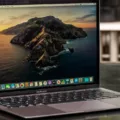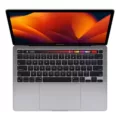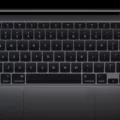The Macbook Air M1 has been making waves in the tech world since its release, thanks to its incredible performance and efficiency. Powered by Apple’s revolutionary M1 chip, this laptop offers unmatched speed and power, making it a popular choice for both casual users and professionals alike. In this article, we will delve into the features of the Macbook Air M1 and provide some useful tips and tricks to enhance your experience with this remarkable device.
First and foremost, let’s talk about the key features of the Macbook Air M1. One of the standout features is, of course, the M1 chip itself. This custom-designed chip combines the CPU, GPU, and other essential components into a single system on a chip (SoC). The result is a significant boost in performance and energy efficiency. With the M1 chip, you can expect faster processing speeds, seamless multitasking, and improved battery life.
Another notable feature of the Macbook Air M1 is its stunning Retina display. The 13.3-inch display offers vibrant colors, sharp text, and excellent contrast, making it a pleasure to use for work or entertainment purposes. Whether you’re editing photos, watching movies, or browsing the web, the Retina display ensures a visually immersive experience.
In terms of storage, the Macbook Air M1 offers ample space to store your files, documents, and media. You can choose between 256GB or 512GB of SSD storage, depending on your needs. SSD storage not only provides fast data access but also contributes to the overall snappiness and responsiveness of the laptop.
Now, let’s move on to some tips and tricks to optimize your Macbook Air M1 experience. Firstly, it’s essential to keep your system clean and organized. Regularly clean up system files and documents that you no longer need. This will not only free up storage space but also improve overall system performance.
Additionally, it’s crucial to manage startup programs. By disabling unnecessary programs from launching at startup, you can significantly reduce the boot time of your Macbook Air M1. You can do this by going to “System Preferences” > “Users & Groups” > “Login Items” and unchecking the programs you don’t need to start automatically.
Another tip is to remove unused apps from your Macbook Air M1. Uninstalling unnecessary applications not only frees up storage space but also helps declutter your system and improve performance. You can easily uninstall apps by dragging them to the Trash or using third-party uninstaller software.
Keeping your operating system up to date is also crucial for optimal performance. Apple regularly releases macOS updates, which often include bug fixes, security patches, and performance enhancements. Make sure to check for updates regularly and install them to ensure your Macbook Air M1 is running the latest software.
If you find that your Macbook Air M1 is still not as fast as you’d like, consider upgrading your RAM. While the Macbook Air M1 comes with either 8GB or 16GB of unified memory, upgrading to 16GB can provide an additional boost in performance, especially for resource-intensive tasks such as video editing or 3D rendering.
Lastly, consider swapping your HDD for an SSD if you haven’t already. SSDs are significantly faster than traditional hard drives and can greatly improve the overall speed and responsiveness of your Macbook Air M1. If you’re comfortable with hardware upgrades, this is definitely worth considering.
The Macbook Air M1 is a powerhouse of a laptop that offers unmatched performance and efficiency. By following these tips and tricks, you can further enhance your experience with this remarkable device. Whether you’re a casual user or a professional, the Macbook Air M1 is sure to impress with its speed, display quality, and overall user experience.
How Can You Improve Your MacBook Air M1 Performance?
To improve the performance of your MacBook Air M1, there are several steps you can take:
1. Clean up system files and documents: Start by removing unnecessary files and documents from your Mac. Use the built-in Storage Management tool to identify and delete large or unused files. Empty the trash regularly to free up disk space.
2. Detect and kill demanding processes: Monitor your Mac’s activity using the Activity Monitor tool. Identify any resource-hungry processes and close them to free up system resources. This can help improve the overall performance of your Mac.
3. Speed up startup time: Manage startup programs by going to System Preferences > Users & Groups > Login Items. Remove any unnecessary apps from the list to reduce the number of programs that launch at startup, which can help speed up the boot process.
4. Remove unused apps: Uninstall any apps that you no longer use. These apps can take up valuable disk space and may also run background processes, slowing down your Mac. Go to the Applications folder, locate the app you want to remove, and drag it to the trash.
5. Run a macOS system update: Keeping your macOS up to date is crucial for performance improvements. Apple regularly releases updates that include bug fixes and optimizations. Go to System Preferences > Software Update to check for and install any available updates.
6. Upgrade your RAM: If your Mac is still sluggish, consider upgrading its RAM. The MacBook Air M1 has soldered RAM, so this may not be possible for all users. If you have the option, increasing the RAM can significantly improve performance, especially when running resource-intensive tasks or multiple applications simultaneously.
7. Swap your HDD for an SSD: If your MacBook Air M1 has a traditional hard disk drive (HDD), consider replacing it with a solid-state drive (SSD). SSDs are faster, more reliable, and can significantly improve overall system performance.
8. Reduce visual effects: macOS includes various visual effects that enhance the user experience but can consume system resources. To reduce these effects, go to System Preferences > Accessibility > Display > Reduce motion and check the box. Additionally, go to System Preferences > Dock > Minimize windows using and select “Scale effect” instead of “Genie effect.”
By following these steps, you can optimize the performance of your MacBook Air M1 and ensure a smoother and more efficient user experience.

Should You Shut Down Your MacBook Air M1 Every Night?
It is recommended to shut down your MacBook Air M1 every night for several reasons:
1. Clear RAM: Shutting down your MacBook Air M1 allows the RAM (Random Access Memory) to be cleared. RAM is used by your computer to store temporary data and running processes. Over time, some processes may become stuck or use up excessive amounts of RAM, leading to decreased performance. By shutting down your MacBook Air M1, you can refresh the RAM and allow the system to start fresh the next time you turn it on.
2. Updates: Some software updates, including important security patches, can only be applied when you reboot your Mac. By shutting down your MacBook Air M1 regularly, you ensure that any pending updates are installed, keeping your system up to date and secure. This is especially important for maintaining the overall performance and stability of your device.
3. Energy efficiency: Shutting down your MacBook Air M1 at night when you’re not using it helps conserve energy. This is particularly relevant for portable devices like MacBook Air, as they rely on battery power. By turning off your Mac, you can save battery life and reduce your energy consumption, contributing to a more environmentally friendly approach.
It’s worth noting that you can also choose to put your MacBook Air M1 into sleep mode instead of shutting it down completely. Sleep mode allows your Mac to quickly resume its previous state when you turn it back on, providing convenience and saving time. However, occasional shutdowns are still recommended to ensure proper system maintenance.
Shutting down your MacBook Air M1 every night helps clear RAM, allows for important updates to be applied, and conserves energy. It’s a good practice to incorporate into your routine to ensure optimal performance and longevity of your device.
How Often Should You Shut Down Your MacBook Air M1?
According to Apple experts, it is recommended to shut down your MacBook Air M1 if you do not plan to use it within a 36-hour time period. Additionally, it is advisable to shut down your MacBook Air M1 every 3-5 days to ensure optimal performance.
Shutting down your MacBook Air M1 has several benefits. Firstly, it helps clear the operational memory of the computer, allowing it to function more efficiently. This can result in improved speed and responsiveness when you start using your MacBook again.
By shutting down your MacBook Air M1, you also give it a chance to refresh its system and close any unnecessary processes or applications that may be running in the background. This can help prevent potential issues and maintain the overall stability of your device.
What Are the Best Accessories For MacBook Air M1?
The MacBook Air M1 is a powerful and versatile laptop, but there are several accessories that can enhance your experience and make the most out of its capabilities. Here are some of the best accessories for the MacBook Air M1:
1. Charging Adapters: A reliable charging adapter is essential for keeping your MacBook Air M1 powered up. Look for adapters that offer fast charging and multiple ports for added convenience.
2. Laptop Cases and Sleeves: Protect your MacBook Air M1 from scratches, bumps, and spills with a high-quality laptop case or sleeve. Opt for a slim and lightweight design that doesn’t add bulk to your laptop.
3. USB Hubs and Docks: Expand the connectivity options of your MacBook Air M1 with a USB hub or dock. These devices provide additional USB ports, HDMI ports, SD card slots, and other useful connections for connecting peripherals and external displays.
4. Keyboards: While the MacBook Air M1 comes with an excellent built-in keyboard, some users prefer the feel and functionality of an external keyboard. Look for compact and wireless options that offer a comfortable typing experience.
5. Mice: If you find the trackpad of the MacBook Air M1 lacking, consider investing in a mouse. Wireless mice with ergonomic designs and customizable buttons can greatly improve productivity and ease of use.
6. Laptop Stands: Elevate your MacBook Air M1 to a more comfortable viewing angle and improve airflow with a laptop stand. Look for sturdy and adjustable stands that suit your working preferences.
7. Desk Mats: A desk mat can protect your desk surface from scratches and spills while adding a touch of style to your workspace. Choose a mat with a smooth surface for easy mouse movement and a non-slip bottom for stability.
8. External Monitors: Take advantage of the MacBook Air M1’s powerful graphics capabilities by connecting it to an external monitor. Look for high-resolution displays with accurate color reproduction for a more immersive computing experience.
These accessories can enhance the functionality, versatility, and protection of your MacBook Air M1, allowing you to get the most out of your laptop. Consider your specific needs and preferences when selecting the best accessories for your MacBook Air M1.
Conclusion
The MacBook Air M1 is an exceptional device that offers a powerful and efficient computing experience. With its groundbreaking M1 chip, it delivers incredible performance, improved power efficiency, and impressive battery life. The combination of the M1 chip and macOS Big Sur ensures seamless integration and optimized performance for all tasks.
The MacBook Air M1’s compact and lightweight design makes it highly portable, perfect for users on the go. Its stunning Retina display provides vibrant colors and sharp visuals, enhancing the overall user experience. The improved thermal management system keeps the device cool even during intensive tasks, ensuring smooth performance without any thermal throttling.
Furthermore, the MacBook Air M1 boasts fast SSD storage, allowing for quick boot times and snappy app launches. Its advanced security features, such as Touch ID, provide peace of mind when it comes to protecting your data and privacy.
With the M1 chip’s compatibility with a wide range of apps, including both native and emulated versions, users have access to a vast ecosystem of software. This ensures that productivity, creativity, and entertainment needs are met effortlessly.
The MacBook Air M1 is a game-changer in the laptop market, offering unparalleled performance, impressive battery life, and a sleek design. Whether you’re a student, professional, or casual user, this device provides a seamless and efficient computing experience that is hard to match.








